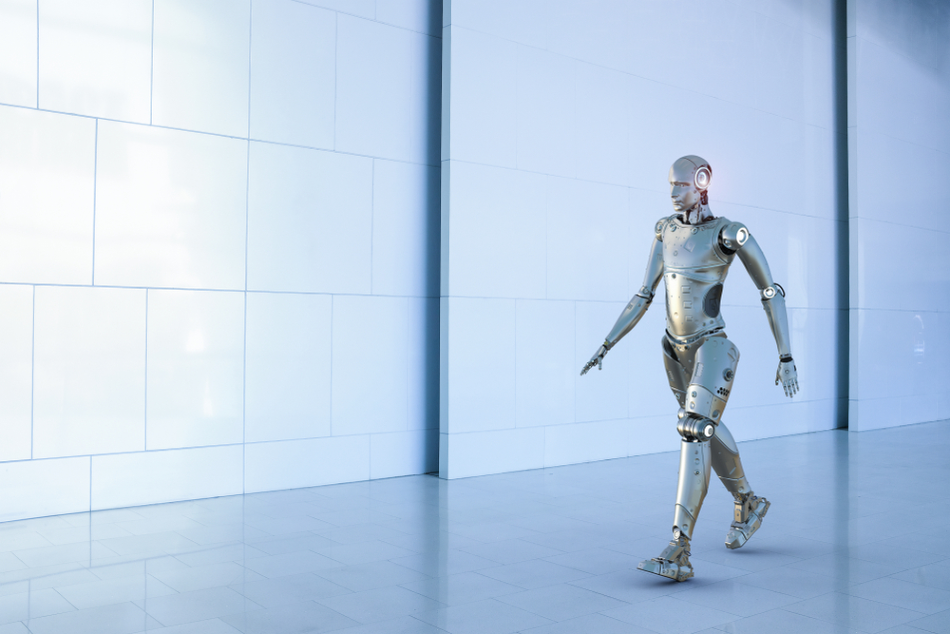By Kalwinder KaurNov 1 2012

Image Credit: Phonlamai Photo/Shutterstock.com
Article updated on 04/03/20 by Stephen Edgar
The aim sounds simple; however it is very complex: design a robot that can duplicate the complexities of the way a human walks and negotiates the challenges of their environment dynamically.
ASIMO Honda’s humanoid robot could execute versatile and smooth motions, making it a great example of a robot being able to adapt its behavior based on its intricate design. However, ASIMO was not capable of moving like a human as it has a non-pendular appearance and initially used about 2 kW during walking. Even after two decades of development ASIMO’s movements were still somewhat “robotic”. Over the last few years, we have seen a major change in robotic actuation from stiff, mainly position-controlled approaches to compliant actuators in force control. Moving towards a model based on compliance has been facilitated by the addition of elastic elements both in series with servo drives and in parallel to the main actuation of robotic systems.
Boston Dynamics, are at the forefront of building advanced robots that can demonstrate human behavior. These days, their Atlas robot can do so much more than walk having been demonstrated running and jumping over obstacles with a deftness that looks organic.
PETMAN
Video Credit: BostonDynamics/Shutterstock.com
Basic Principles
Several techniques are applied based on the optimization of the gait of walking of robots to prevent saturation at the largest stability margin. The key benefits of a larger margin are:
- Hardware that is over-torqued due to testing conditions is prevented.
- The design of a robot to carry more load is encouraged.
- By executing gait patterns, the robot can measure lower bound actuation.
- Utilization of actuation capabilities at the time of unexpected situations such as foot slippage.
Force can be multiplied to satisfy static equilibrium such that the robot can pressurize its own body or ground for gaining net force at each foot for critical joints. Also, with the help of the null space of forces, significant torque reductions can be obtained.
Saturation can be reduced by modifying the vertical distribution of forces by displacing the robot’s center of gravity. As a result, the execution of zero-interaction gait takes place, which means that the forces are adjusted by the body of the robot, a zig-zag motion of the body is then created, called sway.
However, the maximum actuation margin can be achieved by combining null-space utilization and body sway.
Advantages of a Walking Robot
The characteristics of walking robots suitable for terrestrial and space applications are the following:
- Omni-directional motion – Wheeled rovers are subjected to non-holonomic motion constraints, where the velocities (magnitude and or direction) and other derivatives of the position are constrained. The intricacy in the degrees of freedom incorporated into walking robots allows them to walk in any direction like that seen with humans.
- Unique modes of locomotion – The wheels of the robots are actuated or passive, so the robots have unique modes of locomotion. e.g. Roller-Walker hybrid robot is designed with a flip mechanism where the wheel can roll or flip to perform as a foot, important for creating an anthropomorphic form of a robotic structure.
- Access to diverse terrain – Like wheeled robots, legged robots can access the ground, and with advancements in the design and engineering of legged robots, this structure can also access walls, explore areas covered by soft sand, maintain functional capacity during contact with steep slopes.
- Discrete contact points – Walking robots move by contacting the ground at discrete contact points. e.g. SILO 6 robot can place its feet at a distinct point to survey an entire field without disturbing the people.
- Variable geometry – The geometry of the legs of the walking robot can be changed by varying the joint angles, allowing the robot to have a flexible configuration and meaning it can easily fit into tight spaces.
Applications of Legged Robots
Some of the major applications of walking robots are as follows:
- Planetary exploration – As legged robots have high versatility, they are utilized by space agencies like NASA, German Aerospace Center and Canadian Space Agency.
- Personal assistants – Walking robots are used as office or home assistants for performing various tasks like carrying and delivering packages, assisting elderly and handicapped people, cleaning, etc., as they can move in cluttered environments.
- Entertainment and education – Sony has developed a robotic pet, Aibo, which is a significant model for research and education.
- Military cargo transport – Boston dynamics developed a quadruped called Big Dog for assisting soldiers on the battlefield by carrying equipment. Deemed too noisy it has been superseded by their robot dog Spot.
- Forestry – As the legged robots can move over cluttered terrain, they are used for forest management activities like timber harvesting. The Timberjack, developed by the Finnish company Plustech Oy, is used for this purpose.
- Land mine detection and removal – Legged robots are well suited for clearing land mines as they can place their feet at a selected point on the ground, and can be fixed with sensors for mine detection.
References and Further Reading
- Ch´avez.D, Department of Aeronautics and Astronautics, Stanford University, 2011
- Collins.S.H, Wisse.M, Ruina.A, Mechanical, and Aerospace Engineering, Cornell University, USA, Delft University of Technology, NL,2001, The International Journal of Robotics Research, Vol. 20(pp. 607-615).
- http://www.bostondynamics.com/
- https://bostondynamics.com/
- A Curriculum for Simulation-based Robotic Surgery
- Palletizing Robotic Systems
- An Introduction to Robotic Locomotion
Disclaimer: The views expressed here are those of the author expressed in their private capacity and do not necessarily represent the views of AZoM.com Limited T/A AZoNetwork the owner and operator of this website. This disclaimer forms part of the Terms and conditions of use of this website.